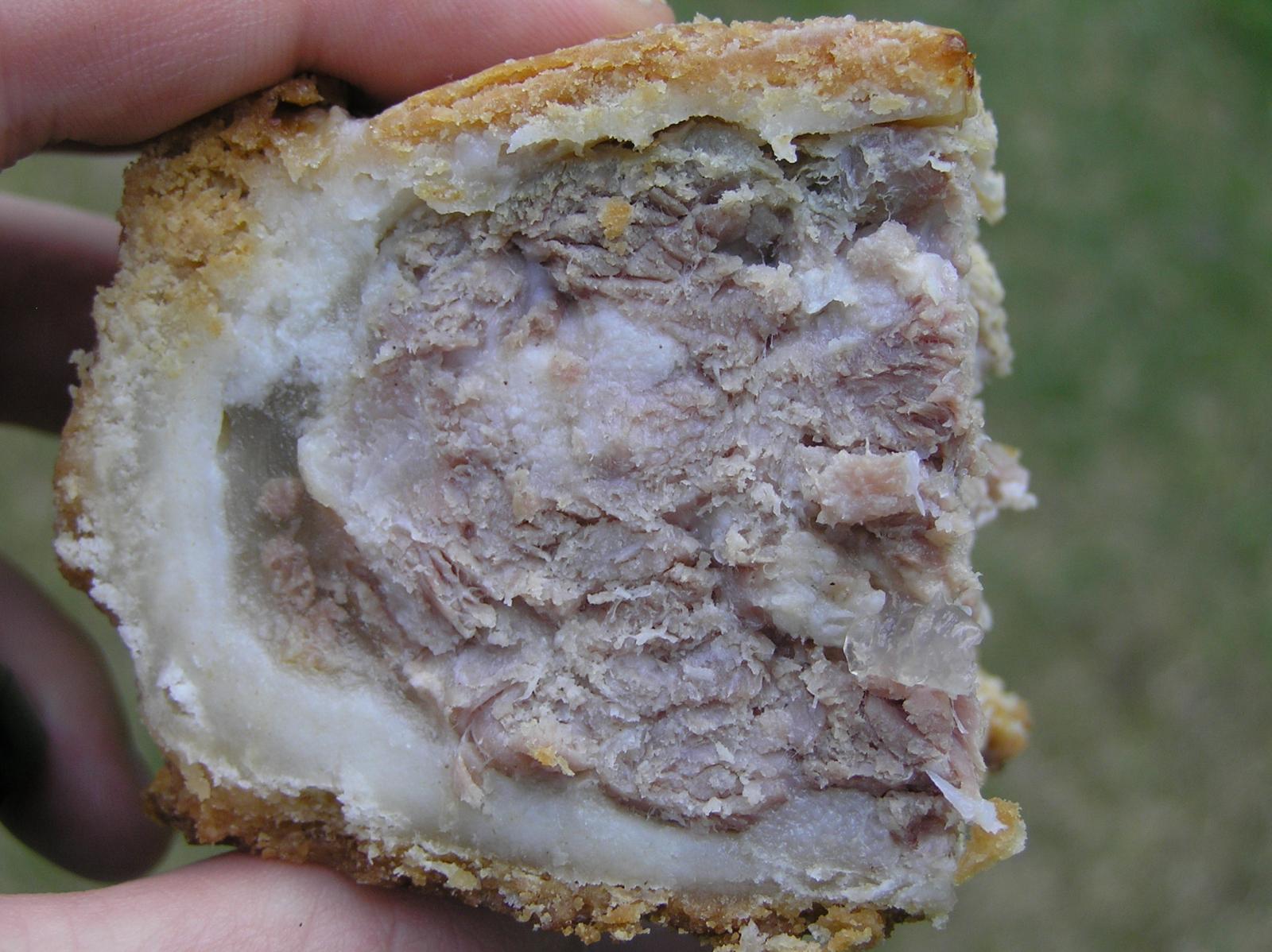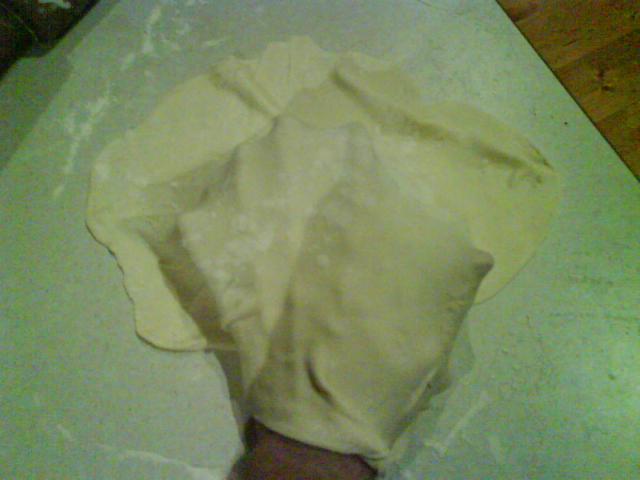-
Posts
4,900 -
Joined
-
Last visited
Content Type
Profiles
Forums
Store
Help Articles
Posts posted by Adam Balic
-
-
It is used in some Moroccan and Ethiopian spice blends. Well worth trying the latter Wat dishes as they are made using some interestingly different cooking techniques.
-
Lemons, like most of the citrus we eat are hybrids. Some of these are natural, but even so their success and dispersal has been due to human action. Lemosn are sour becasue people like them that way, otherwise lemons would just be some change hybrid growing and being ignored like thousands of other fruit trees. Its likely that many of the ancestral citrus were actually quite sour and bitter as this is the state of most of the extant species (like the native citrus in Australia), many animals have no problem at all with eating these.
-
"The Scots Kitchen" mentioned above is a wonderful book, documenting a great deal of Scottish food culture, and is also likely the source of some "Modern Scottish Classics", such as Cullen Skink and Cloutie Dumpling. The first edition has more in it, but later editions contain important recipes like Cloutie Dumpling.
Meg Dods is a classic text.
Practice of cookery and pastry, adapted to the business of everyday life By Mrs. I. Williamson shows the type of cooking that took place in the New Town of Edinburgh during the middle of the 19th century.
In the 20th century there are Scottish WI type books that can be found on ebay. There are also the "The Glasgow Cookery Book", "The Edinburgh Book of Plain Cookery Recipes" and "The Edinburgh book of advanced cookery recipes", although the latter two are a little later then you date of interest.
-
I guess that part of the problem is about the definition of "cuisine". It can mean different things to different people, beyond being simply "Kitchen/recognizable style of cooking". I actually think that it is a poor term, as it doesn't tend to address what people from a particular area and time actually eat in total. It also can imply ownership of a specific dish or cooking technique, but for the most part dishes and cooking techniques don't respect modern boundaries. Most regions also have multiple styles of cooking that while being recognized as separate, can in influence each other. Home v Restaurant cooking, Urban v Country, class specific cooking etc.Some dishes can be made for decades or even centuries in a particular region, but never get recognition as being "local", in other instances is it can take a very short amount of time. In addition if you look at the cuisine of a specific region, it tends to change quite a bit over time, often very rapidly. Most British people would recognize food published (British cookbooks) in 1850 as British, but not from 1800.
"Fish and chips, meat pies, pavlova, meat and three vegs", etc are also representative of Australian foods, so not specifically New Zealand foods. People argue about precedence and some people are very invested in this, but really I don't see much merit in this. If a nations cuisine is based on iconic dishes that as part of that definition have to be owned in total, then it will be teeny tiny list.
The people in New Zealand have a specific diet that changes over time, and it has some recognizable styles of cooking/specific dishes. The two don't have to overlap, although often do and there lies the issue as different people see different degrees of overlap.
-
In general the names are registered, so they will be the same name in different countries.
Sites like the European cultivated Potato Databaseprovide extensive information on individual potato types and there cooking properties.
-
I think that the "grey" comment is a reference to something I wrote on the thread. This is a slice of Mrs King’s Melton Mowbray pork pie, one of the greats. In "Tradional Foods of Britain (Laura Mason with Catherine Brown) describes a MM pie as "greyish-pink and white". Essentially if you have a pork pie with a bright pink interior the meat has been brined (or dyed) and is not a MM pork pie, which I think was part of the original discussion.

-
I must admit that I am in two minds over Protected Geographical Indication status and food. In theory it recognises a particular food item as having a association with a specific location and allows people that have tradionally been associated with a product to gain the greatest benefit from the commercialisation of that product. However, as the product has to be defined in a specific way then in some ways that is the end of the story for it. The Cornish Pasty Association has applied for PGI status, but they have defined A genuine Cornish pasty as having a "distinctive 'D' shape and is crimped on one side, never on top. The texture of the filling for the pasty is chunky, made up of uncooked minced or roughly cut chunks of beef (not less than 12.5%), swede or turnip, potato and onion and a light peppery seasoning.". Ten minutes on a Google search will inform anybody that is interested that in Cornwall pasties contained all manner of fillings, with beef being relatively rare. So in the end it limits tradion of the food item in question for commercial objectives.
Pork pies are more straightforward as the recipe hasn't changed that much since it was developed, although the name has.
1846 recipe: LEICESTERSHIRE PORK PIE.
Cut the pork up in square pieces, fat and lean, about the size of a cob-nut, season with pepper and salt, and a small quantity of sage and thyme chopped fine, and set it aside on a dish in a cool place. Next, make some hot-water-paste, using for this purpose (if desired) fresh- made hog's-lard instead of butter, in the proportion of eight ounces to the pound of flour. These pies must be raised by hand, in the following manner:—First mould the paste into a round ball upon the slab, then roll it out to the thickness of half an inch, and with the back of the right hand indent the centre in a circle reaching to within three inches of the edge of the paste; next, gather up the edges all round, pressing it closely with the fingers and thumbs, so as to give to it the form of a purse; then continue to work it upwards, until the sides are raised sufficiently high; the pie should now be placed on a baking-sheet, with a round of buttered paper under it, and after it has been filled with the pork—previously prepared for the purpose, covered in with some of the paste in the usual manner. Trim the edges and pinch it round with the pincers, decorate it, egg it over and bake it until done: calculating the time it should remain in the oven, according to the quantity of meat it contains.
-
Good work, will be very interested to see how you get along with the pastry forming. Regarding the use of nitrates, the Melton Mowbray Pork Pie (which now has Protected Geographical Indication (PGI)status)doesn't have any nitrates added, just pork, so the meat cooks to a grey colour, generic pork pies mostly contain nitrates and have a bright pink interior. I like the idea of all the spices though and will be interested to read how you describe the taste.
-
As it happens I have just been corresponding with somebody that make these for many years. He is what they have to say:
"50% fine oatmeal, 25% wheatmeal, 25% white flour together with a small amount of yeast, a 'mix' for say 40 dozen, in a dustbin sized plastic container,was proved over about 6 hours until the yeast had risen to the top when it was further stimulated by a small amount of bicarbonate of soda."
I've used a similar recipe and they always turn out well.

-
Hi Dougal, not at odds with Davidson as in this case he is making a guess, rather then offering anything evidence based. As it happens the recipe I have given above is from Scotland and as you can see it doesn't requirer a mechanical grinder/mincer. The recipes remained grinder free for about 40-50 years in many cases.
Basically Shepherds were some of the poorest members of the community and by and large were looking after somebody elses sheep (with some exceptions like Farmer-Shepherds in Cumbria). The sheep are not their's to eat. There are some few accounts of shepherds diet, it is pretty simple and when mutton is mentioned it is mostly braxy mutton (meat from sheep that had died of disease or exposure in the field, not butchered). Essentially if you were a shepherd and were offered meat then you would have taken up the offer, not said, "Sorry sir I couldn't possibly eat beef as I am a shepherd and by etymological association that just doesn't make sense".
On special occasions (like the Shepherd's Meet in Cumbria) you see dishes like Tatie-Pot being mentioned, but essentially there is no evidence that the modern Shepherd's pie is related to this. There is plenty of evidence that Cottage Pie was a way for well to do households to use up leftovers since the 18th century at least, at some point in the middle of the 19th some people started calling the same thing a Shepherd's Pie (mostly in Scotland), by the early 20th century it had settled on the dish of minced meat and potato. Now there is a stage where a dish that is recognised as a "Classic" has to have an appropriate backstory, as part of this Shepherds and Cottage Pie has diverged as dishes, which is interesting.
I should think that the next thing to happen is for some people to insist that it can't be made from fresh mince, as the traditional classic humble dish is made from minced left over roast and therefore making it into a purely middle class event

-
This is an early recipe for Shepherd's Pie (1862), you can see that it is a dish for using up leftovers, nothing to do with Shepherds or Lamb specifically for that matter.
Shepherd's Pie.
Take cold dressed meat of any kind, roast or boiled, slice it, break the bones, and put them on with a little boiling water, and a little salt, boil them until you have extracted all the strength from them, and reduced it to very little, and strain it. Season the sliced meat with pepper and salt, lay it in a baking dish, pour in the sauce you strained, and add a little mushroom ketchup. Have some potatoes boiled and nicely mashed, cover the dish with the potatoes, smooth it on the top with a knife, notch it round the edge and mark it on the top the same as paste. Bake it in an oven, or before the fire, until the potatoes are a nice brown.
-
In my experience, leftover gravy is as rare as leftover shepherd's pie - but I'll hold some gravy back for just this purpose next time.Lamb is very expensive in Canada and there's never enough left over to use in this way.
So true! We never had any leftover lamb, so my family has always used beef mince and called it shepherd's pie anyway. Maybe it's a Canadian thing.
Not really, pretty much all the early (1870-1900) recipes use whatever meat was leftover. The name was ment to add a bit of romance to essentially a way of using up leftovers, not actually refer to anything that Shepherds actually ate. Before the 1870's the same thing was called a Cottage Pie.
People have only got worked up about Shepherd = lamb, Cottage = Beef in the last few decades as far as I can determine.
-
The Davis source makes no claim on the precedence of the name to a particular fruit, where as etymological sources like the OED are quite explicit. But whatever, next time I will be happy to leave people able to spell correctly, but ignorant of what the food stuff actually is.
-
Terribly sorry about the spelling, typying one handed, feeding a baby at 4 AM will do that on occasion.
As it happens that name of the dried grape and the Ribes sp. has been a source of confusion for some time. The true currant is actually the dried grape (Black Corinth/Zante), as the Ribes sp sold as a fresh fruit is actually named after them. An early reference to the Ribes sp is "Bastard Corinthes"
-
I love it when I try an ingredient for the first time and all expectations are exceeded. I had some black mini grapes last night for desert -- wow. These things are very small, as in 1 concord equals 100 corinths. The petite dark cluster on my white plate looked like a small mammal's lung engorged with venous blood. Each tiny fruit was silky purple and loaded with concentrated grape flavor. I felt like a Friendly Giant vampire after his first kill.
Who grows them? What does a mini vineyard look like?
They look like regular grape vines. You know that these are the grapes that currents are made from? "Current" is a contraction of "Raisin of Corinth" (or "Raisins de Corauntz" in Anglo-French).
-
In my specific case the oven is a major problem. This was cooked in an oven that was pre-heated for 1 hour, then on a pizza stone, underneath a hot grill. Maximun temperature is 180.C. There are many poor quality ovens on the market now and my landlord bought one of these.
I'm not bothered so much by the addion or not of yeast. The pastry is very thin, but the moisture content means that it will puff up a little anyway.
-
First, sorry about the quality of the images.
OK, I actually think that is is quite a difficult dish to make in a domestic setting for a number of reasons. I have trouble due to the below par oven I have at the moment. Neverthelesss there are some things that improve the end product a lot.
1. Oven needs to be very hot, even more important then for pizza. The base is very thin, and the quantity of raw onion means that it is very easy to burn the base, without cooking the onion.
2. Ingredients are very simple, so they need to be high quality, if you use cream or cheese that has been stabilised with gums et al., then the effect is a really nasty and pasty. If you can't get decent fromage blanc or crème fraîche then use good quality cream. The idea is that the fat in the dairy will help create the lovely golden surface (which I can't achieve in my oven).
3. Pastry base is very fine, not like a pizza base at all, more like a thick crepe (completely different texture though obviously).
The rolled out pastry, this is further thinned by stretching out.

Base with topping.

As far as I can take it in my oven. I can't brown the surface effectively without burning the base. But it gives you the general idea I guess.

-
Odd to rename "Tarte Flambée" as "Tarte d'Alsace". Interesting description seen on a commercial version "A French style flat bread with ham, caramelized onions and gruyere cheese". Actually I think that I shall make one tonight. My major issue with making these at home is that I can get the oven hot enough to evaporate the moisture without making the pasty soggy.
Regarding dairy. I usually use fromage blanc or half fb, half cream. Any thoughts on this?
-
Let me know if you want an English description.
Sngo Chrouk Bangkang
Sngo Choeung Chamni Chroux
Samlaa M'Chou Moan
Chang Ploeung
Samlaa Kako
Samla Kaeng Phet
Ngiev Kroeung
Samlaa Sach Tia Nung Phile
Trey Chamhoy
Amok
Chion Trey Chab
Chion Trey I
Chion Trey II
Loclac
Chha Sakh Ko Kroeung
Chha Sakh Ko
Chha Sakh Ko Khatna
Chha Sakh Chrouk, Tauhou, Sandaek Bandoh
Chha Sakh Chrouk, Chamlok, Holantav
Chha Mii Su
Chha Dangkeab Kdam
Chha Tompang
Sakh Ko Changkak
Nheam Moan
Nheam Sakh Ko Salat
-
The excellent "South East Asian Food" by Rosemary Brissenden has a very good selection of Cambodian recipes.
-
To be honest, this isn't really a Cornish Pasty, it is a medieval Catalan empanda, contains a cut up chicken, spices, salt pork, herbs etc. Takes about 2 hours in a slow oven.
These on the otherhand are pasties, as found in Cornwall. These take about 50 minutes to cook.

-
I've had very good luck with these.
KENSINGTON PALACE SCONES
This scone recipe is said to have graced Queen Victoria’s tea table.
Preheat oven to 415 degrees F.
2 cups all purpose flour
2 TBSP. sugar (may add more or less if you prefer)
3/4 teasp. salt
1 TBSP. baking powder
1/3 cup Crisco
1/3 cup butter
1/3 cup milk
1 beaten egg
Sift dry ingredients together, mix with shortening using pastry cutter
or food processor.
Add milk and egg, mix lightly with fork until just barely mixed.
Turn on to floured board, knead 8-10times, flattening and folding over entirely onto itself at final kneading.
(Very important)Pat out gently to about 1/2 inch height and cut with
a biscuit cutter, going straight down and straight up. If you twist, scones will be lopsided when baked.
Bake at 415 for about 12-15 minutes or until golden brown.
These may be coated with an egg wash of one egg beaten with a
couple TBSP. water before baking if you wish.
Notes:
Handle dough as little as possible. You will have to fold it together after the initial cutting to cut the rest, but be gentle.
These can also be cut with a 1 1/4" cutter for smaller scones, which are nice for children or if you are having many people to tea.
These can be made ahead, cut and frozen, then thawed and baked
if you prefer. They are best done with freshly made dough though.
The last folding is what gives them the place in the middle to
tear them apart after baking.
These are a flaky scone, not a cake-like one.
Queen Victoria had Crisco? Who knew.
This the oldest English recipe for a chemical raising agent scone type recipe that I have come across, if the raising agent is replaced with modern baking powder it still produces a very good scone.
The New London Cook by Duncan MacDonald (1808).
American Potash Cakes
Mix a pound of flour, and a quarter of a pound of butter; dissolve and stir a quarter of a pound of sugar in half a pint of milk; and make a solution of about a tea-spoonful of salt of tartar, crystal of soda, or any purified potash, in half a tea-cupful of cold water; pour them, also among the flour, work the paste up to a good consistence, roll it out, and form into cakes or biscuits. The lightness of these cakes depends greatly on the briskness of the oven.
-

Pimp my Pasty.
-
Like I said, my family were and are farmers and have been since at least the 16th century as far as we can tell. I think that I have a pretty good idea of farming and poverty in general. Which isn't the point. The point is if small scale and local is such a fantastic model for feeding large modern population centres, giving maximum potential to the inhabitants and minimum environmental impact, then where is it? Where is the actual fact and data?
To date this is the only data I've found on meat consumption in Mexico City. If true even in 2006 meat (specifically pork) consumption was very low (very very low for much of the population), yet the population size means that this is a huge amount of food and associated infrastructure to deal with it. If it is a historical fact that pre-1994 all the food in Mexico City was supplied from small local farmers, then how was this done and how could it realistically be applied now, giving maximum potential to the inhabitants and minimum negative health and environmental impact?
I should say that I would love it to be true that small and local is the solution (or even a solution) as that is were my heart is, but my intellect says otherwise. I heard a few to many personal accounts of the lives of say Contadini in Italy (or my own family in Croatia) to be convinced by third hand stories of how wonderful a small farmers (usually called a "peasant" for some reason) existence is in pre-agrarian reform Europe was.



Long Pepper
in Cooking
Posted
It is worth noting that a lot of long pepper on the market is very poor quality. Good quality long pepper has a very complex, sweet aroma, when it is of lesser quality this is lost and it smells very musty.